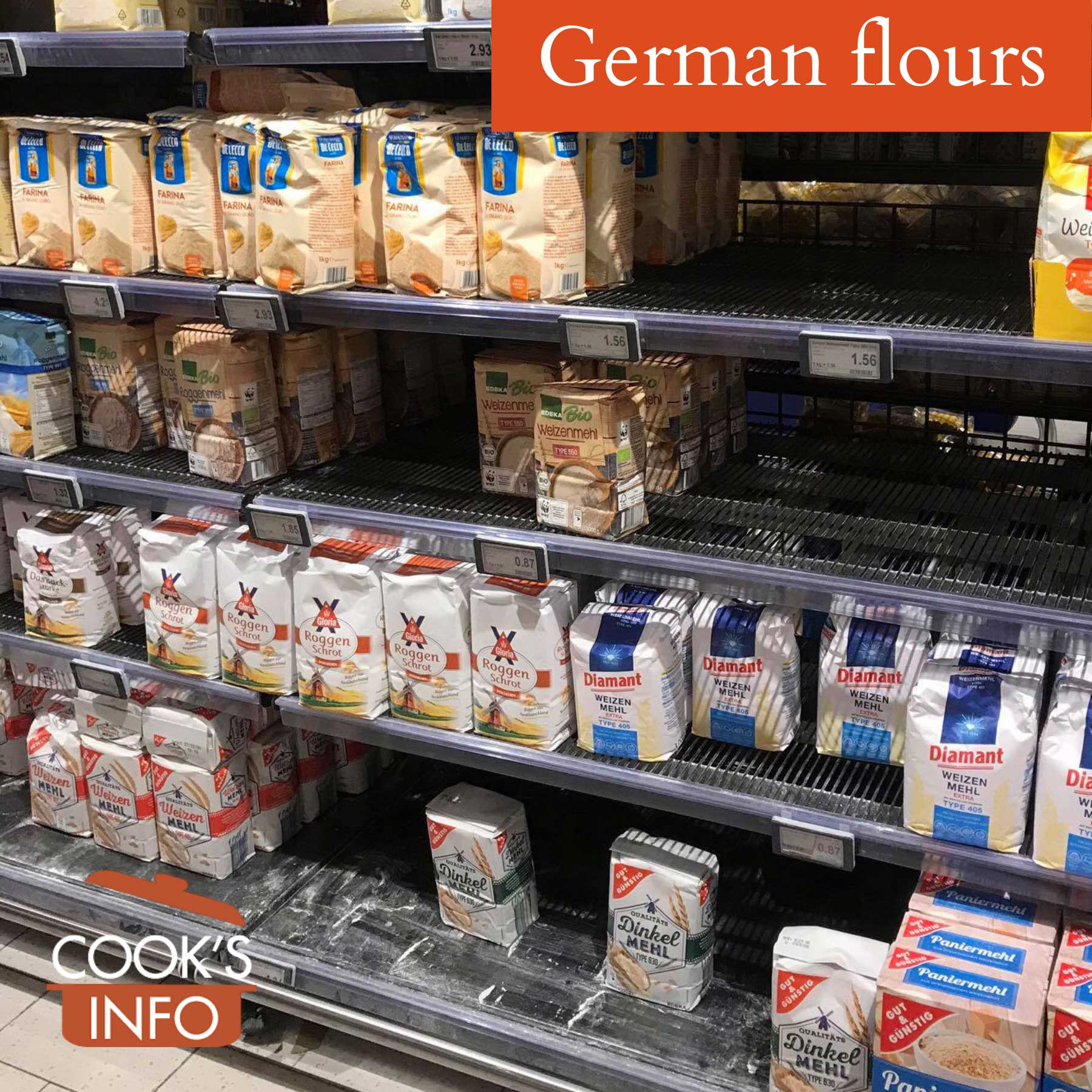
German flours at supermarket in Hamburg. © Hanne Casperson / 2020
In Germany, a wide variety of grain flours are sold and used. Unlike other Western countries, where anything other than a wheat flour is a “novelty” or “health” flour, in Germany rye flour and spelt flour are still used relatively commonly.
The common size of bags of flour are the smaller ones typical of Europe, rather than the typically larger bags sold in Canada or America.
The two types of flour most commonly used for bread in Germany are wheat flour Type 1050 and rye flour Type 1180.
The German flour grading system is also used in Switzerland. It is not, however, identical with the system used in Austria.
German flour grading system
In Germany, flour is graded by “type numbers” (“Mehltypen”) which indicate the ash content of the flour.
To determine the grade, flour is burnt at 900 C (1652 F) until only a minute amount of ash remains. That ash will be the minerals that were in the flour. For type 405 flour, if 100 g (about 3 oz.) of it is burnt in this way, then 405 mg of ash will remain. This is about a .4% ash content.
The higher the type number, the more minerals there are in the flour to form ash if the flour is burnt.
This grading system has been in effect in Germany since 1934. The grading system was revised and updated in 1992 into what is now called the DIN standard 10355 (DIN stands for Deutsches Institut für Normung e.V. — German Institute for Standardisation.)
Flours in the .4% ash content range are usually for households; flours in the .5 to .7 range are usually for small bakeries.
The higher the type number, the “more whole grain” and therefore darker the flour is. The amount of protein and fibre will also increase with the type number, until you arrive at complete whole grain which will have no type number as it is deemed to be 100%.
The type number does not refer to a specific grain: the same type numbers can be applied to flours as various as wheat, spelt, rye, etc.
Some of the wheat flours will be ground from low-protein soft wheat; others from higher-protein hard wheat.
German Wheat Flours
Wheat flour is called “Weizenmehl” in German.
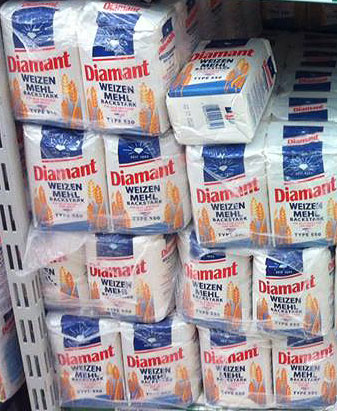
Weizenmehl / © Sven Wachsmuth / 2004
| Flour type | Ash content | Extraction Rate | Protein |
|---|---|---|---|
| Type 405 | 0.405% | 50% | 8 to 10% |
| Type 550 | 0.50% to 0.58% | 72% | 9 to 11% |
| Type 812 | 0.64% to 0.89% | 80% | 11 to 13% |
| Type 1050 | 1.050 % | 13 to 14.5% | |
| Type 1600 | 1.6% | ||
| Type 1700 | 1.7% |
Type 405
Type 405 is a very fine, low-gluten content wheat flour made from soft wheat.
It can be used for sauces and baked goods. It gives a very fine crumb to baked goods.
It is the closest German flour equivalent to American cake flour. However, type 405 has a protein content of 8 to 10% compared to cake flour, which will have 6 to 8%. Consequently, some people say it can be a challenge to make a cake or pastry recipe written for English speakers with German flour, as the German protein content is too high.
This is not good for yeast-risen products, as it won’t do a great job of developing enough gluten to hold the gasses in to rise the dough.
Type 405 is the most popular household flour in Germany. It is classed as “type W480” in Austria.
Substitute: to make German type 405 with American or Canadian flours, combine 1 ⅓ cups (185g) all-purpose flour and ⅔ cup (90g) cake flour. [1]Flours. German food guide. Accessed October 2020 at http://www.germanfoodguide.com/flours.cfm
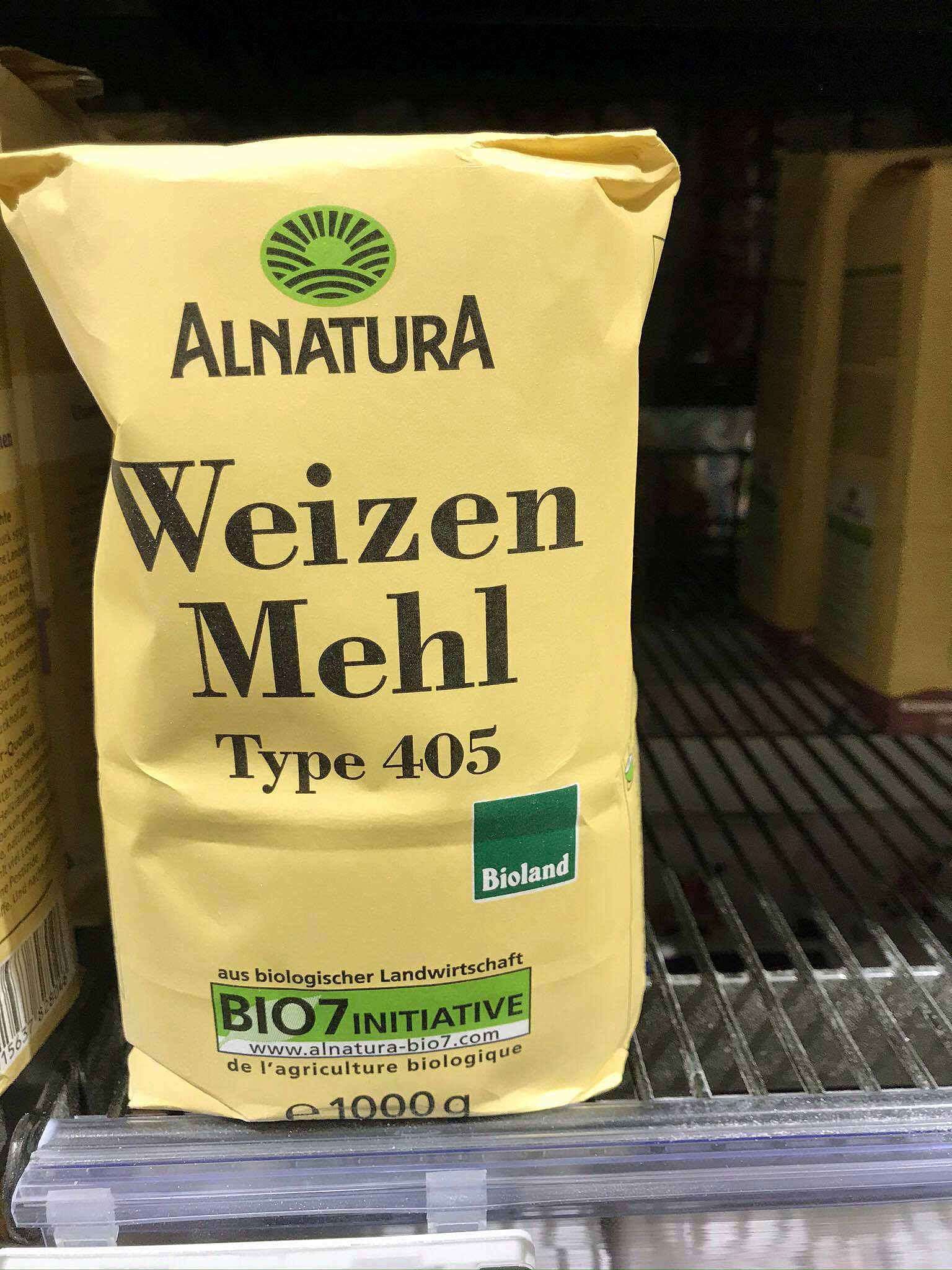
German wheat flour / Weizenmehl type 405. © Hanne Casperson / 2020.
Type 550
Type 550 is a wheat flour with medium gluten content that is good for baked products leavened with yeast. It is ground a little finer than North American all-purpose or British plain flour, but otherwise, with a protein content of 9 to 11%, it is Germany’s equivalent. It may be bleached or unbleached.
As it is all-purpose flour, it is understandably popular with home cooks (though note that type 405 above is more popular), but is typically not used by professional bakers. Amongst other things, it can be used for homemade white bread.
It is classed as “type W700” in Austria. [2]Leimüller wheat flour type 550 / W 700. Accessed October at https://agrarzone.com/Leimueller-Wheat-Flour-Type-550-/-W-700-

German wheat flour / Weizenmehl type 550. © Hanne Casperson / 2020.
Type 812
Type 812 wheat flour, with a protein content of 11 to 13% is a higher gluten content flour and is Germany’s equivalent to English or American “bread flour.” It is made from a hard wheat. It will be a pale yellowish colour when freshly ground, turning an off-white as it ages. It will feel just slightly coarse in your hands.
With the higher gluten content, it is good for yeast-risen breads. Sample uses include lightly-coloured breads and rolls, and artisan breads such as “farmer’s bread” (“Bauernbrot”). In the kitchen or bakery, it is often used in combination with rye flour when making breads that are a combination of rye and wheat flours.
It is not as commonly found in German supermarkets as other flour types.
Aka Bauernbrot Mehl.
Substitute: Half type 550 and half type 1050.
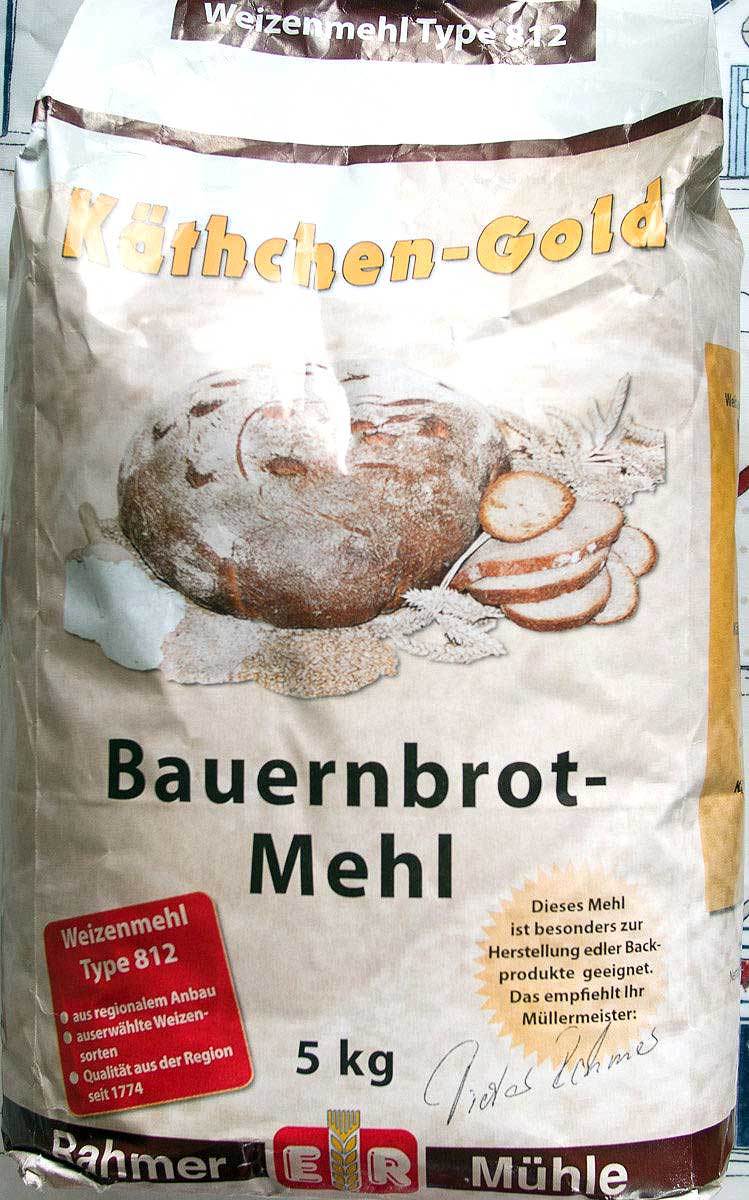
German flour type 812. TwoFlower / Open Food Facts / CC BY-SA 3.0
Type 1050
Type 1050 wheat flour is darker than North American unbleached flour. It is a high-gluten flour made from hard wheat, with more of the wheat grain remaining in the flour that the smaller type numbers. It will have a gluten content of 13 to 14.5%.
It is often used in combination with other flours for darker-coloured breads. It is also good for very stretchy doughs such as that for pizza and bagels.
It is classed as “type W1600” in Austria. [3]Haberfellner Flour Type 1050 / W1600. Accessed October at https://agrarzone.com/wheat-flour-type-1050-w1600-haberfellner
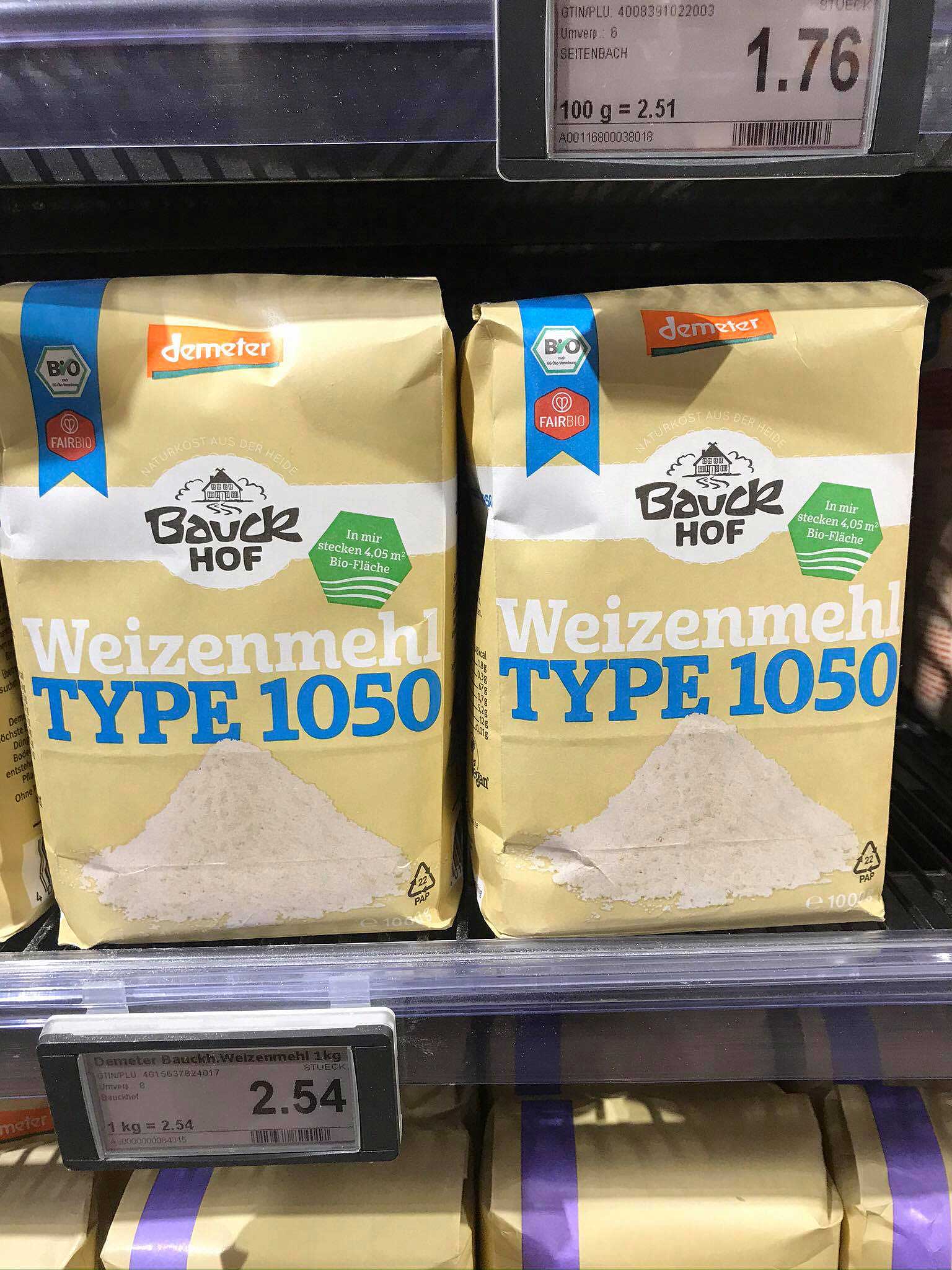
German wheat flour / Weizenmehl type 1050. © Hanne Casperson / 2020.
Type 1600
Type 1600 wheat flour is often used for darker-coloured mixed flour wheat and rye breads. It is very close to whole wheat flour, but not quite. [4]Weizenmehl Type 1600 – Mein Dunkles-aber-kein-Vollkorn-Brot-Mehl. Haben Sie das von Ihren Familienmitgliedern schon mal gehört, wenn vollwertiges Brot auf den Tisch kommt? Für all Jene haben wir uns was ausgedacht. Entnimmt man dem Vollkornmehl geringfügig Schalenteile, dann kommt ein Weizenmehl Type 1600 heraus, das immer noch so viele Ballaststoffe enthält um die Verdauung der Lieben in Schwung zu halten.” Weizenmehl Type 1600. Accessed October 2020 at https://www.zinssermuehle.de/Weizenmehl-Type-1600
This will require a bit more water than other lower-number flours when making bread.
Whole Wheat Flour
German full grain wheat flour has no type number assigned to it. The whole, complete wheat grain is used in making the flour.
It is called “Vollkorn”, meaning literally “full grain.”
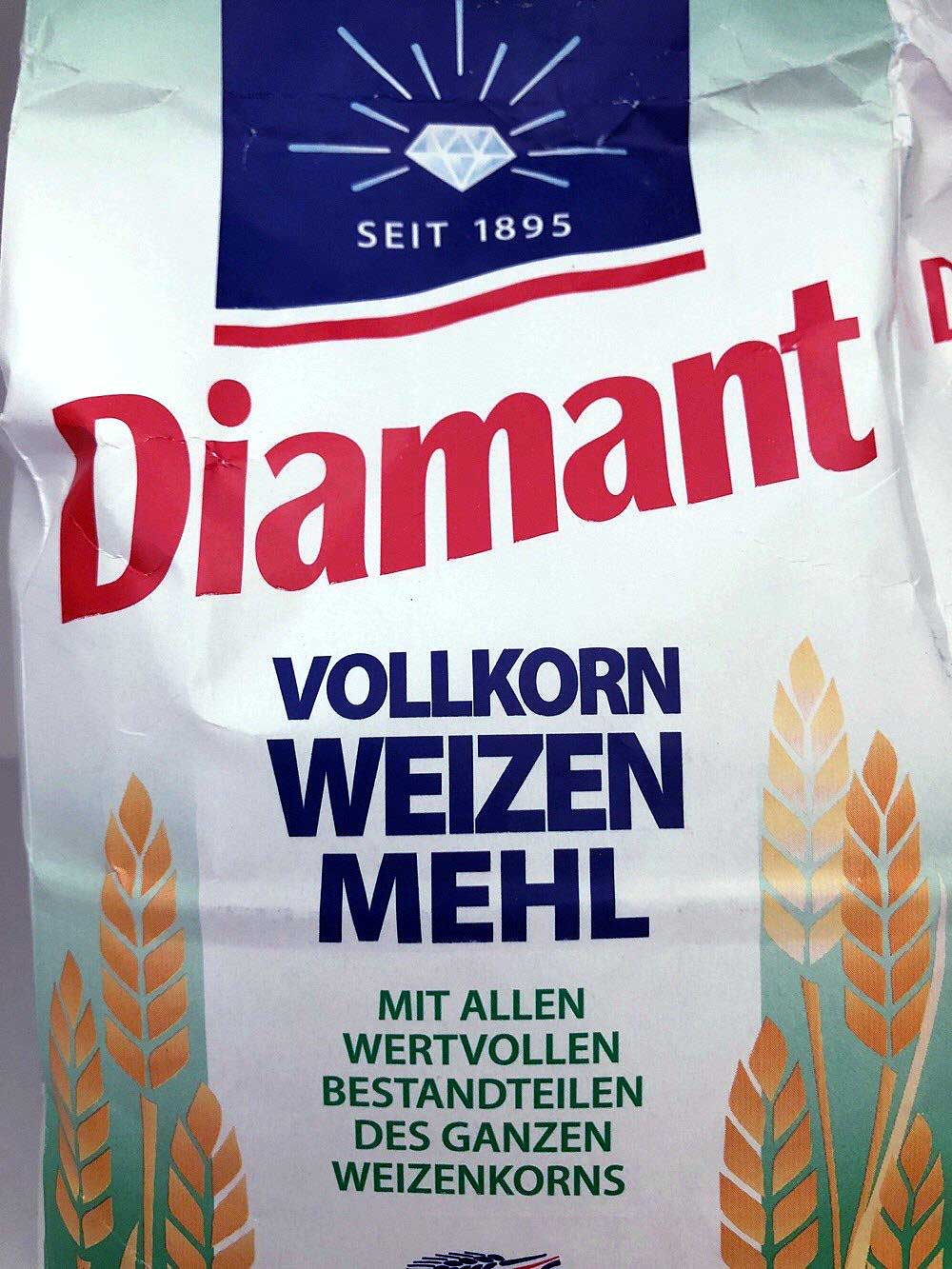
German whole wheat flour / Vollkorn. Date-limite-app / Open Food Facts / CC BY-SA 3.0
German Rye Flours
In Germany, rye flour is called “Roggenmehl.”
Several different grinds and “ash contents” are available, labelled by “numbers” (as is common with some other European flours.)
The higher the number, the darker the rye flour. For instance, type 1150 is a medium to dark rye flour.

German Rye Flour / Roggenmehl. kiliweb / Open Food Facts / CC BY-SA 3.0
German Rye Flour Types
| Flour type | Ash content | Protein | Notes |
|---|---|---|---|
| Type 815 | 0.815% | Very light, good for very light rye breads. Austria (where it is called Type R500), and in Southern Germany. | |
| Type 960 | 0.85% to 0.96% | 8% | Light rye flour |
| Type 997 | 0.997% to 1.09% | Good for sourdough breads. Close to type R500 in Austria. | |
| Type 1150 | 1.15% | Close to type R500 in Austria. | |
| Type 1180 | 1.18% | ||
| Type 1370 | 1.37% | Dark rye, good for sourdough breads | |
| Type 1740 | 1.74% | Pure dark rye | |
| Type 1800 | 1.70% to 2.10% | Coarsely ground |
German Spelt Flour
Spelt flour is called “Dinkelmehl” in German.
It is commonly sold in everyday flour sections of supermarkets along with other flours. Its use is more common than it is in English-speaking countries.

German spelt flour / Dinkelmehl type 1050. © Hanne Casperson / 2020.
German Spelt Flour Types
| Spelt flour type | Ash content |
|---|---|
| Type 630 | < 0.70% |
| Type 812 | 0.71% to 0.90% |
| Type 1050 | 0.91% to 1.20% |

German spelt flour / Dinkelmehl type 630. © Hanne Casperson / 2020.
Austrian flour types
In Austria, you will the flour type preceded with a letter, such as W480. The W stands for “Weizen” (wheat); R stands for “Roggen” (rye), and D stands for “Dinkel” (spelt). [5]Wer ist dieser Typ W 480 und was macht er in meinem Mehl? 5 June 2019. Accessed October 2020 at https://www.bohpro.at/mehltyp-und-seine-bedeutung/ [6]Österreichisches Lebensmittelbuch. Bundesministerium: Arbeit, Soziales, Gesundheit und Konsumentenschutz. Page 6. Accessed October 2020 at https://www.verbrauchergesundheit.gv.at/lebensmittel/buch/codex/B20_Mahl_und_Schaelprodukte.pdf?7a1jn7
| Type | Ash content | Extraction Rate | Protein | Notes |
|---|---|---|---|---|
| W480 | 0.33% to 0.58% | 8 to 10% | Fine white wheat flour for pastries, etc. Corresponds to German type 405. | |
| W700 | 0.66% to 0.79% | 72% | 9 to 11% | White flour with good adhesive properties. Corresponds to German type 550. |
| W1600 | 1.50% to 1.75% | Dark wheat flour, almost whole wheat. Corresponds to German type 1050. | ||
| Weizenvollkornmehl | 1.5% to 2.3% | 100% whole wheat flour | ||
| R500 | 0.43% to 0.57% | Fine rye flour. Corresponds to German Rye type 815. | ||
| R960 | 0.88% to 1.12% | Normal rye flour. Between German types 997 and 1150. | ||
| R2500 | 2.00% to 3.00% | Coarser, darker rye flour | ||
| D700 | Fine spelt flour | |||
| D1050 | Normal spelt flour |
Other Austrian terms
The following terms in Austria describe not how whole grain a flour is, but rather how finely it is ground regardless of how much of the whole grain is left in it. [7]Mehlkunde: glatt, griffig, universal. Vienna, Austria: Servus Magazine. Accessed October 2020 at https://www.servus.com/rezepte/mehlkunde-glatt-griffig-universal/
Glattes Mehl
“Glattes Mehl” means literally “smooth flour.” It is a very fine, powdery flour good for dusting, sauces, pastries.
Griffiges Mehl
“Griffiges Mehl” means literally “gripping flour.” It is ground a little more coarsely than “glattes Mehl.” Good for pasta, dumplings, yeast-risen pastry doughs, potato doughs, etc.
Doppelgriffiges Mehl
“Doppelgriffiges Mehl” means literally “double gripping flour.” It absorbs liquid a little more slowly than the other two grinds. Good for flouring surfaces with, and dough that needs to rise a good deal and maintain a firm structure while doing so.

German gripping flour / Griffiges Mehl. Date-limite-app / Open Food Facts / CC BY-SA 3.0
Language Notes
Roughage in German is “Ballaststoffe”. The Germans refer to ash content (which would be “Aschegehalt des Mehls”) as “Mineralstoffgehalt” (mineral content).
References
| ↑1 | Flours. German food guide. Accessed October 2020 at http://www.germanfoodguide.com/flours.cfm |
|---|---|
| ↑2 | Leimüller wheat flour type 550 / W 700. Accessed October at https://agrarzone.com/Leimueller-Wheat-Flour-Type-550-/-W-700- |
| ↑3 | Haberfellner Flour Type 1050 / W1600. Accessed October at https://agrarzone.com/wheat-flour-type-1050-w1600-haberfellner |
| ↑4 | Weizenmehl Type 1600 – Mein Dunkles-aber-kein-Vollkorn-Brot-Mehl. Haben Sie das von Ihren Familienmitgliedern schon mal gehört, wenn vollwertiges Brot auf den Tisch kommt? Für all Jene haben wir uns was ausgedacht. Entnimmt man dem Vollkornmehl geringfügig Schalenteile, dann kommt ein Weizenmehl Type 1600 heraus, das immer noch so viele Ballaststoffe enthält um die Verdauung der Lieben in Schwung zu halten.” Weizenmehl Type 1600. Accessed October 2020 at https://www.zinssermuehle.de/Weizenmehl-Type-1600 |
| ↑5 | Wer ist dieser Typ W 480 und was macht er in meinem Mehl? 5 June 2019. Accessed October 2020 at https://www.bohpro.at/mehltyp-und-seine-bedeutung/ |
| ↑6 | Österreichisches Lebensmittelbuch. Bundesministerium: Arbeit, Soziales, Gesundheit und Konsumentenschutz. Page 6. Accessed October 2020 at https://www.verbrauchergesundheit.gv.at/lebensmittel/buch/codex/B20_Mahl_und_Schaelprodukte.pdf?7a1jn7 |
| ↑7 | Mehlkunde: glatt, griffig, universal. Vienna, Austria: Servus Magazine. Accessed October 2020 at https://www.servus.com/rezepte/mehlkunde-glatt-griffig-universal/ |

